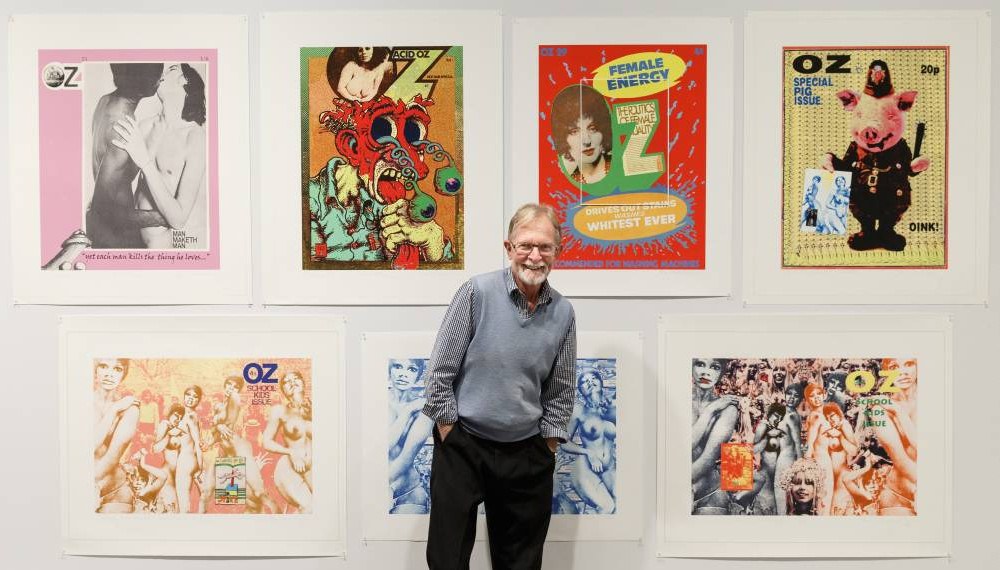
When I was away from Australia for 30 years and lived for almost 20 of those years in a communal town called Bolinas on the north coast of California, I was very used to community. Group shows, group magazines and group everything. It all belonged to the town and I was an active member of the town. So, when I came back to Sydney it was a bit of a wrench. It was difficult. I can’t remember how I graduated into TAP, but once I discovered TAP in 1994-95, I took to it like a duck to water. I wasn’t an established artist in Sydney and so it was a very easy way for me to show my work.
“I don’t hold anything back. You know I’ve put in some very satirical stuff into TAP and some confrontational work at Mardi Gras time and I’ve never had any trouble. Some a little bit of a worry, and I hope that’s ok – it’s always been ok.”
Jim Anderson
I trained as a lawyer, but very quickly discovered after I graduated and worked for the Attorney General’s Department, it wasn’t for me. I really wanted to be a writer, or an artist. I went to the National Art School, back when it was called the East Sydney Tech, and I didn’t relate very much to anything. I couldn’t draw, couldn’t sculpt, or paint. So, I gave that up and went to London in the 60s. London wasn’t much better, but I still had the desire for being an artist only I wasn’t sure of what sort. I tried writing and went to Morocco for a year and wrote a novel, while experimenting on drugs, good rugs, marijuana, a little bit of acid and it opened my eyes to the world of the artist. As for something over there which is like TAP, well bohemian life is wherever you go, you tap into it.
“TAP would just fit right in at The Chelsea Antique Market of the ’60s in London. If Lesley had been there she would have been Lesley Dimmick in London”.
Jim Anderson
I got involved with Oz magazine in London and became the art editor and eventually they caught us and sent us to jail for a while, over the school kids issue. They charged us with conspiracy to corrupt public morals which is just nonsense. We took it seriously and it turned into a bit of a show-biz trial. We dressed up as schoolboys for the preliminary hearing and had lots of photographs taken of us as schoolgirls and policemen and all sorts of funny pictures. We were convicted of the minor charge, not conspiracy, went to jail, got released and on appeal were vindicated.
I think it’s very important to have freedom of expression and to have something like TAP around which doesn’t censor. We have been moving into a more conservative era for some time, so freedom of expression becomes more and more important because if you live in that puritanical conservative era, you tend to get caught up with self-censorship. Having absolute utter freedom from censorship, you get away from that idea of self-censorship. It’s very insidious, as you don’t know that you are doing it and at TAP Gallery you don’t have to worry about it. Lesley has never censored me and I’ve put in some pretty explicit stuff. I’ve put art into things like the Amnesty show, the Environmental show and particularly the Gay Out Loud show.
Audio Arts: Jim Anderson interviewed by Angela Stretch [14 March 2015] transcription by Jacqui McCarthy
BIOGRAPHY
Jim Anderson is a British-Australian editor and novelist. He edited OZ Magazine and later wrote the novels Billarooby (1988) and Chipman’s African Adventure (2015). Anderson returned to Sydney in the mid-1990s and has since pursued a career as writer and photo-artist. In 2011 he mounted a major retrospective exhibition: “Lampoon: An Historical Art Trajectory” at the Tin Sheds Gallery, University of Sydney, February 18 – March 12, 2011. Later that same year, (2011) LAMPOON was exhibited at South Hill Gallery, Goulburn. In June 2016 Billarooby, Anderson’s first novel was re-published by Valentine Press.
